Greetings, cowpokes! Before you get run plumb off the range by a wild pack o’ varmints, let’s drop our cabooses by this here cookfire an’ swap tales o’ the
magical finance.
OK, that’s more than enough of that.
I wanted to write this entire article in a hokey Wild West dialect, but I ran out of steam after, like, three minutes. The idea seemed great in the shower
this morning, and I knew it would have made this the most memorable article of the year for about three of you, but for everyone else, though-including
myself-it would have been torture. Things would have gotten especially dire once I started running out of phrases from the Old West writers’ guide and had to start making
things up.
Hornswoggle my toads, perhaps there’s a Magic finance lesson in there, somewhere?
And here it is: if you’re going to do something that relies on the interest of others-say, writing an article or speculating on a card-make sure that
you’re producing something other people are actually going to want.
It’s always nice when a random card from Legions spikes from $5 to $10, but those gains are often hard to monetize; only a small handful of people actually
care. Stores are slow to raise buylist prices on casual cards, and many kitchen table and Commander players refuse to pay higher prices until the jump has
proven that it will stick. Competitive players don’t have that choice, and Spikes are also more used to dealing with quickly fluctuating values. If you can
trade niche cards straight up for cards that everyone wants, the deal is almost always going to be worth your time. This is a sneaky way to ‘gain value’
while also trading fairly.
What cards should you target right now? Well, the best way to evaluate card demand is to analyze the Top 8s of recent events. This is where most players
look for inspiration, making it one of your most valuable resources as a trader. These days, it’s nearly impossible to find a surprise card in a Top 8 deck
that hasn’t already spiked, but the prices for staples still lags considerably behind our real-world knowledge of how those decks actually perform. You can
still beat the market, providing you’re dealing in cards that are mostly known quantities and you’re willing to be a little patient.
This week, I’m going to talk about each deck that finished in the Top 8 of the Star City Games Standard Open in Cincinnati and then take a look at trends
over the latest season. It also gives us an excuse to take an in-depth look at how Journey into Nyx has changing the Standard format so far, so giddy up,
and let’s ride!
Creatures (16)
Planeswalkers (1)
Lands (25)
Spells (18)
Sideboard

When I saw the title of this deck I was hoping for a Pharika brew, but she is nowhere to be seen at the top table. Instead, we get a slight tweak on the
Mono-Black Devotion deck that has been dominating Standard for the past few months. The only real difference, besides the sideboard and the mana base, is
the addition of three Abrupt Decays and a Vraska to the main deck.
Even though Mono-Black Devotion shows no signs of letting up, many of the key pieces have dropped in price by almost 50% over the past month. This is
mostly due to impending set rotation, which will strip the deck of most of its creature base. I doubt this strategy will be viable next season unless M15
or the fall set brings a lot to the table.
What won’t rotate are Hero’s Downfall and Thoughtseize. It is very likely that there will be a tier one deck running four copies of each of these cards
well into next year. Both cards have leveled off since their peaks, too, making them very solid buys right now. I am very happy to trade for these at $20
and $5 retail respectively. It’s okay to fear rotation to some degree, but don’t assume that next year’s staples are going to vary wildly from the cards
that are excellent today. The only thing that will change is reduced availability.
I also like trading for Abrupt Decays right now, even though the card will rotate in September. Abrupt Decay has been on a value climb for the past few
months, and rotation is doing nothing to satiate demand. This is one of those cards that will be a Modern and Legacy player for years. Get in now, because
if people need them for Standard this summer too, the price could keep rising quickly.
Planeswalkers (7)
Lands (17)
Spells (36)
- 5 Plains
- 5 Island
- 1 Syncopate
- 1 Negate
- 1 Elixir of Immortality
- 4 Azorius Charm
- 4 Supreme Verdict
- 4 Detention Sphere
- 4 Sphinx's Revelation
- 2 Celestial Flare
- 4 Dissolve
- 1 Banishing Light
Sideboard

Much like every list in this Top 8, U/W Control did not benefit much from Journey into Nyx. There’s one maindeck Banishing Light and a couple of Nyx-Fleece
Rams in the sideboard, but this is otherwise the same old U/W shell we’ve seen for months.
It is worth noting that thousands of Jace, Architect of Thoughts were dumped into the supply stream thanks to the Duel Deck, causing the price to tank, but
that supply should be drying up at some point this summer. There isn’t much upside there, but the price can’t get too much lower. I like Supreme Verdict a
little better as a spec because it sees Eternal play, though.
U/W doesn’t use much from Theros, so this deck shouldn’t be much of a factor next season, but it’s likely that Elspeth, Sun’s Champion will show up in
whatever white control deck does survive. The card’s incredible dominance in block is worth noting as well. Picking those up now at $20 retail is fairly
safe as long as we don’t find out that she is the subject of next year’s duel deck.
Creatures (17)
- 3 Scavenging Ooze
- 1 Obzedat, Ghost Council
- 2 Blood Baron of Vizkopa
- 2 Archangel of Thune
- 1 Lifebane Zombie
- 4 Sylvan Caryatid
- 4 Courser of Kruphix
Planeswalkers (3)
Lands (25)
Spells (15)

If you had told me two weeks ago that a Junk deck had Top 8’d the first weekend that Journey into Nyx was legal, I would have assumed that the deck had at
least two copies of Athreos, God of Passage. Nope! The new cards pulling their weight here were Banishing Light; Ajani, Mentor of Heroes; and a singleton
copy of Mana Confluence.
This is the second time we’ve seen Banishing Light crop up, and the need for that card will only grow after Detention Sphere rotates. Don’t forget that the
number of uncommons in each set went up starting with Born of the Gods, meaning that there could be a serious demand crunch here at some point. $2 retail
is a bargain for this card.
Much like black has two slam-dunk staples for the next year in Thoughtseize and Hero’s Downfall, green will probably continue to be centered around Courser
of Kuphrix and Sylvan Caryatid. Neither card is cheap right now, but demand for both will likely stay steady while supply continues to decrease as we move
away from drafting Theros block. Trading for these is fine if you think you’ll want to play with them.
Ajani, Mentor of Heroes is probably not going up from $25, but it’s time to stop thinking of him in Ral Zarek terms. His probable future now feels more
like Kiora and most of the other good planeswalkers. He should stabilize in the $18-$20 range.
Advent of the Wurm is the card here with the most upside. It’s a four-of in this deck, and it has mostly been left for dead this season. It’s an incredible
card in a vacuum, though, and short term demand could spike this into the $4-$5 range before rotation if enough people decide to go in this direction.
Currently, the retail price of this card is just $1.50. I don’t love buying in-rotation is too soon-but you could do worse than picking up a set on spec,
considering how low the price is.
Creatures (1)
Planeswalkers (7)
Lands (27)
Spells (25)

Finally: Keranos, the first (and only) new god in this Top 8.
He is only a one-of here, though, so I imagine that the price will come down, even though I expect people to continue building around him. The foundation
of this deck is very similar to the U/W Control build, and it is centered around Supreme Verdict and Sphinx’s Revelation, just like the builds that don’t
run red. If I had to take a guess based on what I’m seeing here, I’d say that Elspeth and Banishing Light will make up the core of post-rotation white
control decks. Elspeth, most interestingly, appears in five of these eight lists.
It’s worth bringing up here that six of the top eight Standard decks from this event rely fairly heavily on Mutavault. Indeed, that land is the most
important card in Standard by far. Its price reflects that, too, and a set of these will set you back well over a hundred dollars. I don’t expect Mutavault
to return in M15, but if it does, you’ll get a small window to buy in as the supply increases considerably. If you can do so, you should-the card has
proven itself an eternal staple of the highest order.
If Mutavault doesn’t return, the price should drop at rotation, though it will probably not go lower than $20-$25. Mutavault does see play in Modern, but
not in every deck-it mostly shows up in Merfolk and Faeries. I wouldn’t go nuts expecting this card to be the next Mox Opal or anything, but if you have a
set for Standard and you play Modern at all, hold onto it. If you need a set, wait until October and buy in then when it should approach its low.
Creatures (12)
Planeswalkers (2)
Lands (25)
Spells (21)

B/W Midrange has been around for months; it’s basically Mono-Black Control except with the two good Orzhov control finishers (Blood Baron & Obzedat)
and a couple of Elspeths thrown in for good measure. The only Journey into Nyx addition to the main deck of this particular build is two copies of Mana
Confluence, so again, not much has changed.
Did we all overrate Mana Confluence during the pre-order period? It’s come down in price a little from the $20 it started at, and so far it hasn’t spawned
any new hot decks. It did show up in a few existing strategies, though, which bodes fairly well for its future. It is rare that true innovation happens
right away in Standard, so the fact that people are trying out a card at all and doing well with it says good things about its future. My hope is that it
will continue to drop a little as the summer progresses, allowing more people to buy in, but long-term I still expect the card to be a strong performer in
Standard. It is still going to end up as most influential card from Journey into Nyx.
Creatures (17)
Lands (25)
Spells (18)
Sideboard

This sixth-place deck is the third variant of MBC that we’ve seen in this Top 8. This ‘vanilla’ (chocolate?) version eschews both white and green, instead
opting for Nightveil Specters and straight-up mana consistency. I don’t think this build is quite as powerful as the ones running a small splash,
especially given the lack of diverse sideboard options here. Again, though, it’s interesting that all of these rotating staples are dropping like a rock
even though the deck keeps doing very well at events.
Why am I suggesting that some of you trade for rotating staples like Pack Rat and Desecration Demon now, when I wrote last week about trying to trade them
away? It’s all about opportunity and timing. The people already worried about rotation are in it for the long haul-for them, it’s time to drop these cards
like they’re burning holes in their binder. For those of you who trade more actively, however, there’s money to be made here. Mono-Black Devotion and U/W
Control are still the two best decks in Standard, and they likely will be for the rest of May, all of June, all of July, all of August, and half of
September. If you can dump a bunch of slow moving casual stuff for another player’s entire tier one rotating deck, you’ll still have several months of
tournaments where people are going to need these cards. It’s important not to overpay, because the prices will likely continue to drop on some of this
stuff, but rotation breeds desperation. If you can get a good deal on stuff that’s still easy to move, you’ll do very well for yourself.
Creatures (6)
Planeswalkers (4)
Lands (22)
Spells (28)
- 4 Island
- 2 Syncopate
- 2 Thoughtseize
- 1 Negate
- 2 Doom Blade
- 1 Essence Scatter
- 4 Supreme Verdict
- 2 Detention Sphere
- 3 Sphinx's Revelation
- 2 Devour Flesh
- 3 Hero's Downfall
- 1 Dissolve
- 1 Banishing Light
Sideboard

Hey, look, it’s a mishmash of the best cards from the mono-black deck mashed into a brew with some of the best cards from the U/W deck! This deck is closer
to the U/W control build, leaning on Sphinx’s Revelations and Supreme Verdicts, but it does bring some intriguing creature choices to the table in the form
of Brimaz and Aetherling.
Brimaz is worth talking about a little more. He hasn’t shown up enough to really justify his $22 price tag, which is to some degree still based on his
considerable upside. However he has shown up in winning decks enough to tease what he is capable of in the right metagame. Based on current play, Brimaz
should be in the $12-$15 range, but very few cards have his potential to shoot toward $50 if next season breaks his way. Right now, I’m not buying in or
trading for these, but I’ll be watching the deck database and the Open streams very closely.
Creatures (26)
- 3 Scavenging Ooze
- 4 Ghor-Clan Rampager
- 4 Elvish Mystic
- 3 Polukranos, World Eater
- 3 Sylvan Caryatid
- 4 Stormbreath Dragon
- 1 Xenagos, God of Revels
- 4 Courser of Kruphix
Planeswalkers (8)
Lands (10)
Spells (16)

We’ve seen this deck kicking around the top tables for a while, and the only new cards here are a couple of copies of Harness by Force and Unravel the
Aether in the sideboard. This deck is based in green, taking advantage of the triumvirate of awesome that is Sylvan Caryatid, Courser of Kuphrix, and
Scavenging Ooze.
Unlike the Mono-Black and U/W based decks, the majority of this archetype will survive rotation in the autumn. Replacements will need to be found for
Mizzium Mortars, Domri Rade, Ghor-Clan Rampager, and whatever doesn’t survive from M14 to M15, but I’d be shocked if some version of G/R beats doesn’t see
play next season. That makes cards like Xenagos (both versions); Polukranos, World Eater; and Stormbreath Dragon reasonable trade targets from those who
believe that everything in Standard is going to drop off a cliff this summer.
Adding It Up
If you look at the Top 8 in its entirety, there are 49 rares, mythic rares, or uncommons that show in quantities of at least one playset. Here they are,
sorted by frequency of occurrence:
|
20 |
|
|
20 |
|
|
18 |
|
|
17 |
|
|
15 |
|
|
13 |
|
|
12 |
|
|
12 |
|
|
12 |
|
|
12 |
|
|
11 |
|
|
11 |
|
|
11 |
|
|
11 |
|
|
11 |
|
|
10 |
|
|
9 |
|
|
9 |
|
|
9 |
|
|
8 |
|
|
Courser of Kuphrix |
8 |
|
7 |
|
|
7 |
|
|
7 |
|
|
6 |
|
|
6 |
|
|
6 |
|
|
6 |
|
|
5 |
|
|
5 |
|
|
5 |
|
|
5 |
|
|
4 |
|
|
4 |
|
|
4 |
|
|
4 |
|
|
4 |
|
|
4 |
|
|
4 |
|
|
4 |
|
|
4 |
|
|
4 |
|
|
4 |
|
|
4 |
|
|
4 |
|
|
4 |
|
|
4 |
|
|
4 |
|
|
4 |
This world still belongs to the Esper, and we’re all just living in it.
None of these numbers should shock you, since we just went over all of these decks, but before you read this article, how many of the top ten cards could
you have named?
The most interesting trend here, to me, is that the scrylands are more popular than the shocklands in Standard right now. There are more Temples of Silence
floating around in the Top 8 than Godless Shrines, and just as many Hallowed Fountains as Temples of Enlightenment. Overall number of shocks in this Top 8?
42. Overall number of Temples? 53. People are speculating that the Temples might drop in price this fall when the next batch of fixing comes out, but I
doubt it. If the Temples are already better in this format than a set of lands that have long been considered among Magic’s historically best fixing, I can
only imagine that demand will continue to be steady into the fall as the price dries up. If you do not have your full set of Temples now, start trading.
Just don’t expect the carryover to continue into Modern-scrylands are okay there, but with fetchlands in the format, shocklands are quite a bit better.
Trending Topics
Here are the Top 8 appearances for each major archetype at each SCG Open so far this season. Note that I’ve played a little fast and loose with deck
categorization, for the purposes of this experiment, because the more data I can lump together, the better our info will look. Top 8s are already such
small samples, after all.
The lines below are linear regressions, looking for correlation in the data. Some of these rises are strongly correlated, while others are thrown off by
odd results and small sample sizes.
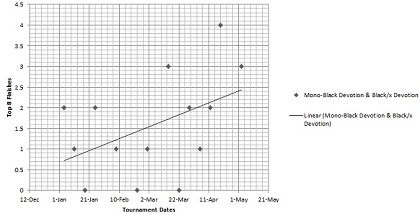
Mono-Black Devotion and the B/X Devotion decks are continuing to do better and better as the season continues to unfold.
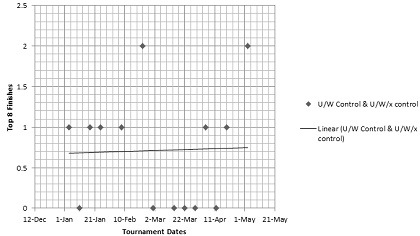
U/W Control has been steady, always placing between 0-2 decks in the Top 8 since the beginning of the year at a fairly steady rate.
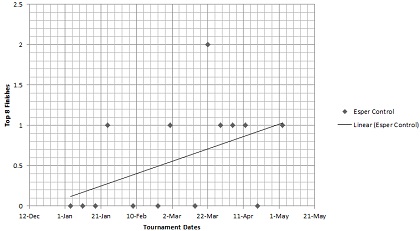
Esper Control has started placing more decks in the Top 8 in recent weeks, though you can clearly see how small the sample size is for many of these
builds-a couple of dud finishes would reverse this trend entirely.
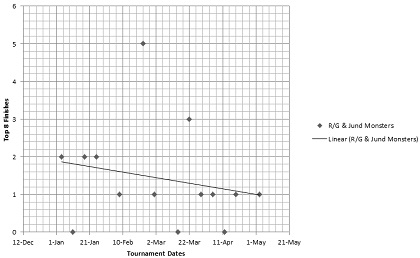
R/G and Jund Monsters show a slight negative regression as the season wears on.
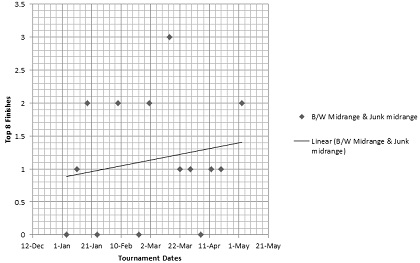
B/W Midrange has had just one tournament since February without at least one appearance in the Top 8. Before that, there were three.
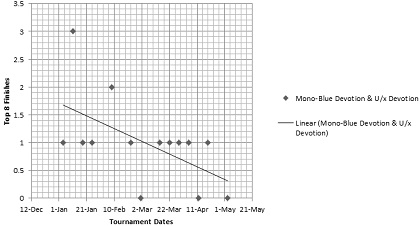
Here’s a very strong trend line showing the decline of Mono-Blue Devotion.
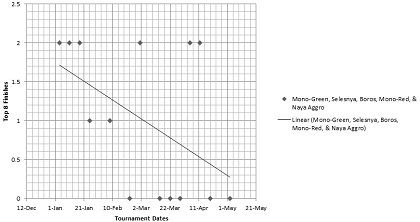
You can also see the clear decline in popularity of Naya-related aggro decks. At the begging of the season, they’re averaging two Top 8 finishes per event.
Now, that average is close to zero.
This data is interesting, but only somewhat useful. Top 8 finishes only give us a tiny piece of the puzzle, and the amount of data we’re playing with here
is tiny. Ideally, we’d want to plot the finish of every single deck in each event, something that should be possible, given enough time to parse the
information. Anyone out there need an idea for a new article series?
This Week’s Trends
The big news this week, of course, was the announcement of a judge foil Force of Will. This is something
that I’ve predicted would happen for a while, and it’s nice to see it finally occur.
These cards won’t be distributed like normal judge foils, though-instead, they’ll be mailed to all judges who have certified another judge since 2005.
According to my friends in the judge community, that is about a thousand people. Luckily, Helene Bergeot has confirmed that there will be future
opportunities to get a Force of Will as well, though she has yet to reveal what they are. I highly doubt they will be released in normal packets, though.
They could start up a Guru-esque program where new judges can earn them by certifying other judges at Level Two, or perhaps they’ll just release them to
judges at conferences or as recognition for helping WotC out under exceptional circumstances.
I had expected these to settle in the $500 range, but I couldn’t find anyone willing to sell theirs online for anywhere close to that number. Most judges
getting one said that they wouldn’t sell for less than about $2,000. And then I heard about another judge who offered his at $750 and got several takers
right away…all of whom promptly backed out when told that they were actually expected to, you know, buy the card.
This is one of those examples of a card where the number of people willing to pay the actual value is going to be tiny. If the price really does settle in
the $750-$1000 range, your only buyers are going to be extreme cubers and the Vintage and Legacy pimp community. Those people exist, and some of them will
need four of these ,but I doubt people are going to be willing to spend more than a grand for this when there’s so much uncertainty surrounding future
supply.
If you absolutely must have one of these, hold off until we know more about how future distribution will be handled. Even if this is limited to something
like 1,500-which I doubt-there will be chances to buy later when the hype dies down a bit. If you’re a judge lucky enough to be getting one of these, you
should either sell right away or hold very long term until the supply has dried up entirely.
As for the other judge foils-Elesh Norn; Sword of Feast and Famine; Riku of Two Reflections; Greater Good; Oloro, Ageless Ascetic; Nekusar, the Mindrazer;
and Hanna, Ship’s Navigator-hold off until the supply increases before you buy in. The best time to buy these is after the market has been saturated but
before the following season’s judge packets are released.

